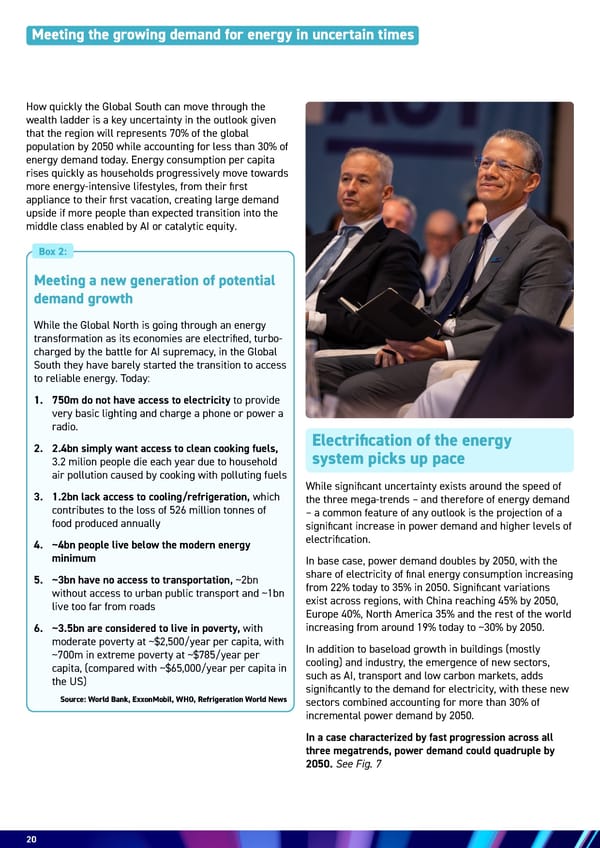20 While significant uncertainty exists around the speed of the three mega-trends – and therefore of energy demand – a common feature of any outlook is the projection of a significant increase in power demand and higher levels of electrification. In base case, power demand doubles by 2050, with the share of electricity of final energy consumption increasing from 22% today to 35% in 2050. Significant variations exist across regions, with China reaching 45% by 2050, Europe 40%, North America 35% and the rest of the world increasing from around 19% today to ~30% by 2050. In addition to baseload growth in buildings (mostly cooling) and industry, the emergence of new sectors, such as AI, transport and low carbon markets, adds significantly to the demand for electricity, with these new sectors combined accounting for more than 30% of incremental power demand by 2050. In a case characterized by fast progression across all three megatrends, power demand could quadruple by 2050. See Fig. 7 Electrification of the energy system picks up pace Meeting the growing demand for energy in uncertain times Meeting a new generation of potential demand growth While the Global North is going through an energy transformation as its economies are electrified, turbo- charged by the battle for AI supremacy, in the Global South they have barely started the transition to access to reliable energy. Today: 1. 750m do not have access to electricity to provide very basic lighting and charge a phone or power a radio. 2. 2.4bn simply want access to clean cooking fuels, 3.2 milion people die each year due to household air pollution caused by cooking with polluting fuels 3. 1.2bn lack access to cooling/refrigeration, which contributes to the loss of 526 million tonnes of food produced annually 4. ~4bn people live below the modern energy minimum 5. ~3bn have no access to transportation, ~2bn without access to urban public transport and ~1bn live too far from roads 6. ~3.5bn are considered to live in poverty, with moderate poverty at ~$2,500/year per capita, with ~700m in extreme poverty at ~$785/year per capita, (compared with ~$65,000/year per capita in the US) Box 2: How quickly the Global South can move through the wealth ladder is a key uncertainty in the outlook given that the region will represents 70% of the global population by 2050 while accounting for less than 30% of energy demand today. Energy consumption per capita rises quickly as households progressively move towards more energy-intensive lifestyles, from their first appliance to their first vacation, creating large demand upside if more people than expected transition into the middle class enabled by AI or catalytic equity. Source: World Bank, ExxonMobil, WHO, Refrigeration World News
 Energy & AI: Twin Engines Turbo-Charging Economic Growth Page 19 Page 21
Energy & AI: Twin Engines Turbo-Charging Economic Growth Page 19 Page 21